In this article
When the weather heats up and we start turning on fans and air conditioners to keep ourselves from sweating, it’s not uncommon for pet owners to wonder if their dogs also sweat to stay cool. The short answer is that dogs do sweat, but that’s not the main way that they cool down. Here, we explain how your dog beats the heat and what you can do to help them out. We also list the breeds that are especially sensitive to excess warmth.

Canine Sweat Glands
Merocrine Glands
Merocrine glands are in the paw pads of a dog’s feet, and they work similarly to human sweat glands, creating moisture on the pads when the dog’s body temperature begins to rise, which helps cool the body as it evaporates. You can often tell when these glands are active because you will see damp paw tracks across the ground as if the dog just got out of the shower.

Apocrine Glands
Apocrine glands are technically sweat glands, but they won’t help your pet stay cool in warm temperatures. Instead, your dog uses these glands to produce pheromones, which help dogs communicate and understand their environment.

Other Ways That Your Dog Stays Cool
Panting
The primary way that your dog stays cool in warm weather is through panting. As your dog pants, they expose the moisture on their tongues, nasal passages, and the lining of their lungs to the air so it can evaporate and cool the body. Rapidly breathing in and out helps move the air over the surface more effectively.
Vasodilation
An interesting mechanism that your dog uses to stay cool that you might not be aware of is vasodilation. This is when the blood vessels in your dog’s face and ears expand and get closer to the surface, which enables more blood to flow through and dissipate heat into the environment, working almost like a natural radiator.

Limitations of Temperature Control
Unfortunately, dogs face limitations in their ability to control their inner body temperature and are more prone to overheating than most humans, especially during strenuous exercise. Their limited number of sweat glands and reliance on panting and vasodilation are not as effective as sweating is for humans.
Furthermore, large dogs with a high muscle-mass-to-surface-area ratio, like Saint Bernards, Great Danes, Rottweilers, and Doberman Pinschers, can find it harder to stay cool than dogs bred for colder weather, like Huskies, Malamutes, Chow Chows, and Samoyeds, can. Finally, brachycephalic breeds, like Bulldogs, Pugs, Boxers, Shih Tzus, and Boston Terriers, are unable to pant efficiently and will find it especially hard to stay cool in warm weather.

How to Help Your Dog Stay Cool
- Always ensure that your dog has access to plenty of fresh, clean water. As the dog pants to stay cool, they can become dehydrated, so ingesting as much water as possible is essential.
- Avoid strenuous exercise in the hotter parts of the day. Try to schedule walks and playtime for early in the morning or after the sun goes down to reduce the risk of your pet overheating.
- Cooling mats and vests can be effective in helping to lower your dog’s body temperature.
- On extremely hot days, it can be a good idea to keep your pet indoors and out of the sun. Use the air conditioner or a fan to bring down the temperature and circulate the air if you can, especially if you have a brachycephalic breed.
- Pavements, asphalt, and sand can get extremely hot and may burn your dog’s paws. Always check the surface with the back of your hand before allowing your pet to walk on it.
- Brushing your dog can remove excess fur and increase air circulation, which can help keep them cool.
- Never leave your dog in a parked car, even for a short time, as temperatures can quickly rise. There may also be laws prohibiting it in many areas.
- Watch for signs of overheating in your dog, which can include excessive panting, drooling, lethargy, disorientation, or vomiting, and contact a vet immediately if you see any.
Did you know you can speak to a veterinarian without having to travel? Just head over to PangoVet. It's our online service where you can talk to a vet online and get the advice you need for your pet — all at an affordable price!


Conclusion
Dogs mostly stay cool through panting, which exposes their moist tongue, nasal passages, and the lining of their lungs to the air. As the moisture evaporates, it cools their body. Your dog also has sweat glands on their paws, and the blood vessels in their face and ears swell to get closer to the surface so they can release heat into the air.
While dogs can stay cool most of the time, high temperatures and extreme activity can push them beyond their limits, as panting doesn’t work as well as sweating, so you should take extra steps to keep your dog cool and hydrated by limiting exercise, keeping them out of the sun, and bringing them indoors if necessary.
Featured Image Credit: movchanzemtsova, Shutterstock


















